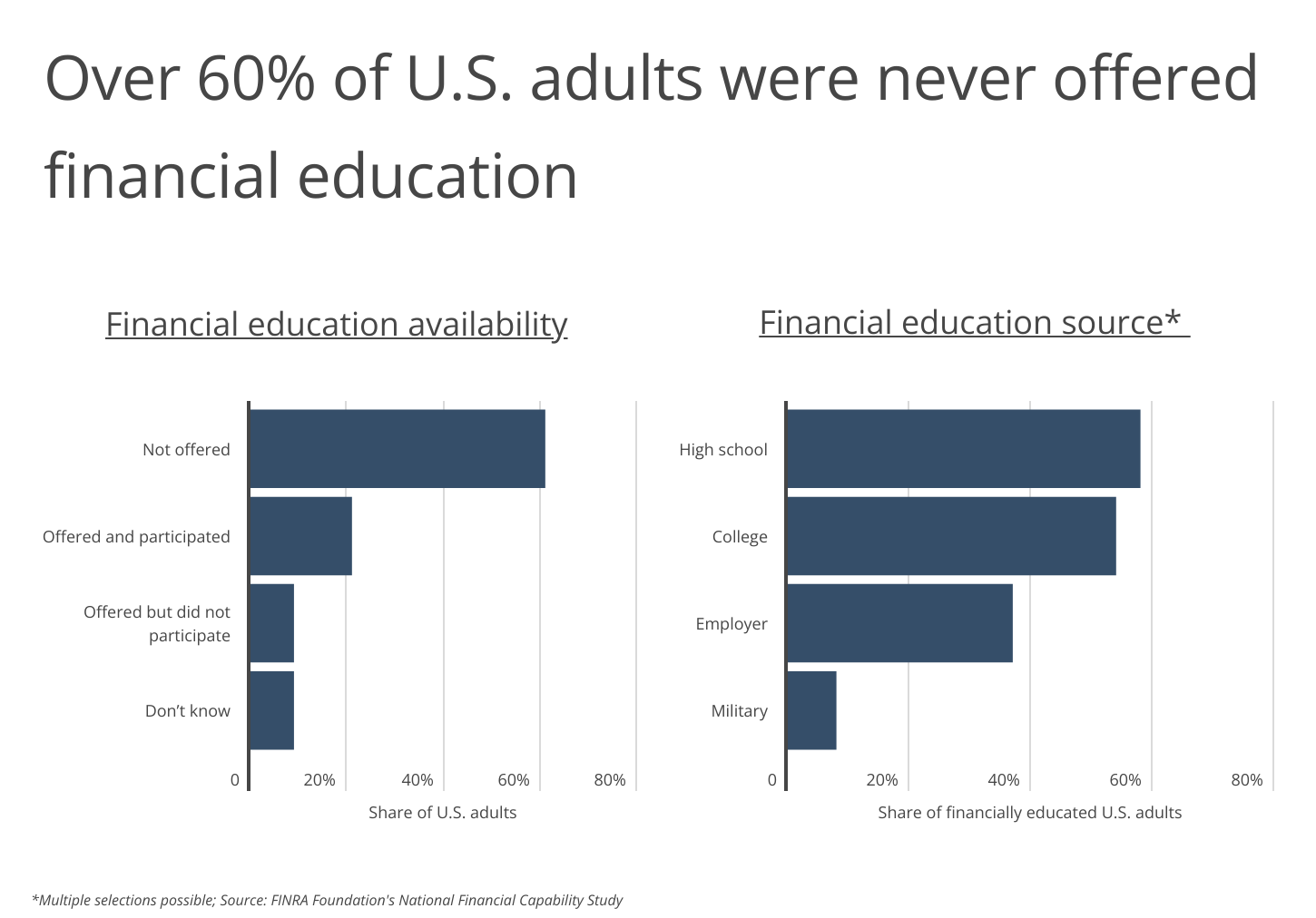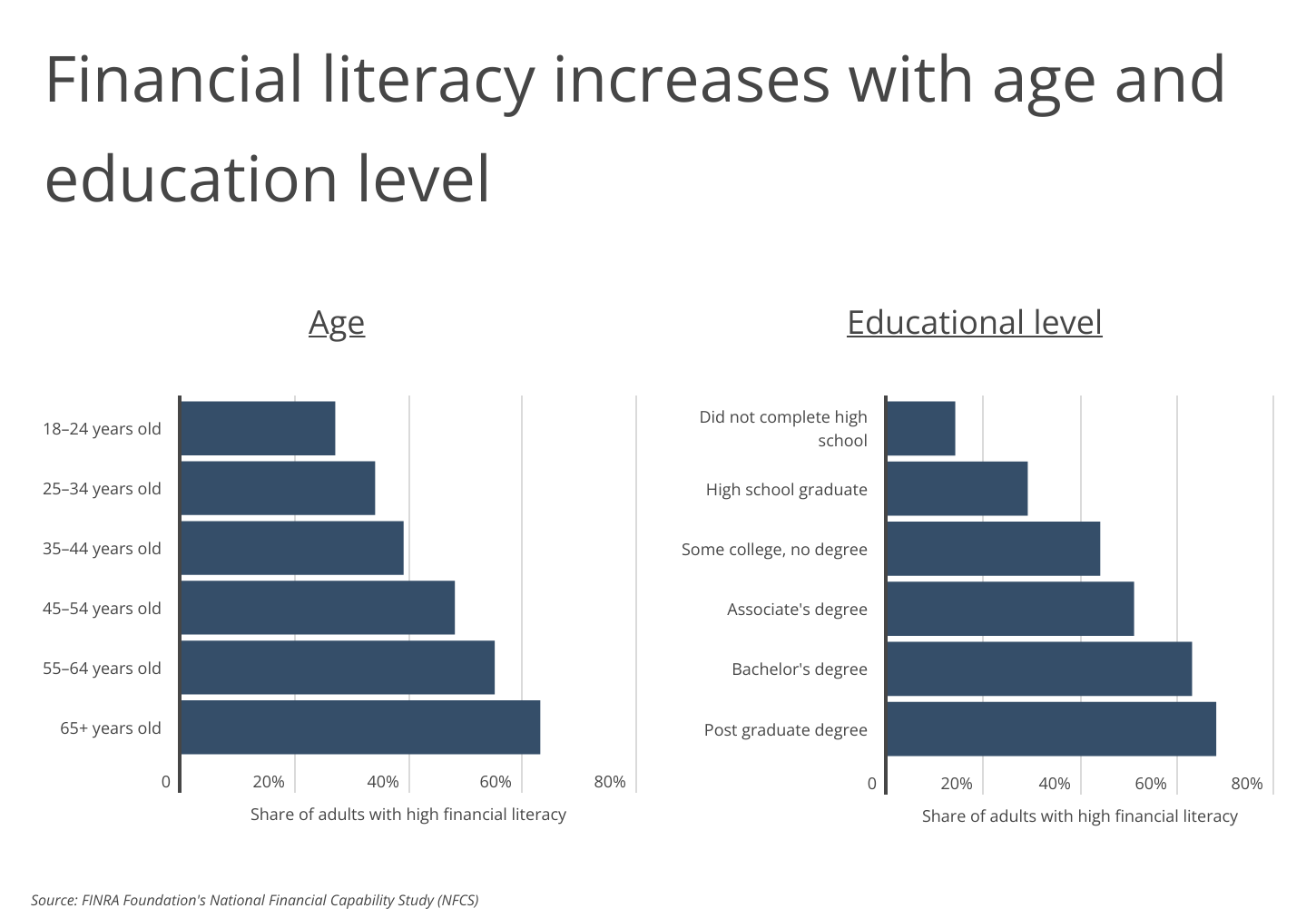The Most Financially Savvy U.S. States [2023 Edition]
To achieve success and stability upon entering the workforce, having a basic understanding of the financial system is crucial. However, many Americans are not receiving the fundamentals of financial education, and a surprising number of young adults already have debt in collections. Moreover, the economic shutdown caused by the COVID-19 pandemic quickly revealed that many Americans do not have the ability to withstand long-term economic hardships.
Some states, including Nebraska, Ohio, and Rhode Island have recently begun to require financial literacy courses for high school students, and more states plan to implement requirements like this in the coming years-an important step in ensuring access to financial education for all Americans. Furthermore, an additional 34 states have addressed financial literacy education in 2021–22 legislative sessions, with 20 of those states focusing on the high school level. In time, perhaps these measures will assist in reversing America’s fading financial literacy.

According to data collected by the FINRA Foundation, the number of U.S. adults who possess basic financial knowledge has been steadily declining, despite increased access to financial information online. In 2009, 79% of U.S. adults had basic interest rate knowledge, while 12 years later in 2021, that percentage had declined to slightly above 70%. Furthermore, over half of U.S. adults had basic investment risk knowledge in 2009. But in 2021, just 42.1% of adults possessed this knowledge. And though the ability to purchase stock holdings and access investing information has become increasingly available, the percentage of U.S. households who own stock holdings has remained around 50% since 2010.
FOR BUSINESS OWNERS
A financially savvy business owner doesn’t only know how to generate profits-they know how to protect their business as well. The best professional liability insurance coverage protects businesses against claims of negligence, misrepresentation, simple mistakes and even inaccurate advice, all of which can be expensive to defend even when the business is not ultimately at fault.

A key issue is that a large majority of Americans are not being taught basic financial literacy. Over 61% of U.S. adults were never offered financial education, while just over 9% were offered an opportunity for financial education but did not participate. Combined, this means that about 70% of U.S. adults haven’t received any financial education.
Of those who did receive financial education, most reported receiving at least a portion of this information in high school (58%) or college (54%). These institutions are important sources of financial education for many Americans, and potentially required financial literacy curricula provides information to those who may not readily seek out information on their own.
LEARN MORE
If your business’ products or services expose your company to a heightened risk of liability, your business would likely benefit from the protection of a commercial umbrella insurance policy-coverage designed to supplement general liability coverage, as well as other coverages.

Despite a lack of formal financial instruction, financial literacy does increase with age and educational attainment. While just 27% of 18- to 24-year-olds have high financial literacy-defined as adults who scored better than the national median on a multiple choice financial literacy exam-over 63% of adults age 65 and older demonstrated the same level of knowledge. Additionally, while less than 29% of Americans who only completed high school have high financial literacy, these numbers jump to 63% for adults with a bachelor’s degree.
While age and education are highly correlated with financial literacy, geography also appears to play a major role. States in the Midwest and Pacific Northwest have the largest shares of adults with high financial literacy, with nine out of the top 15 states located in those regions.
To determine the most financially savvy states, researchers at Smartest Dollar analyzed data from the FINRA Investor Education Foundation. States were ranked based on the share of adults with high financial literacy-defined as those who scored higher than the national median score of 42.9% on FINRA’s Financial Literacy Quiz.
Here are the most financially savvy states in the U.S.
The Most Financially Savvy States

Photo Credit: Loud Canvas / Shutterstock
15. New Hampshire
- Share of adults with high financial literacy: 50.5%
- Share of adults with basic interest rate knowledge: 75.9%
- Share of adults with basic inflation knowledge: 56.7%
- Share of adults with basic investment investment risk knowledge: 46.5%

Photo Credit: Jon Bilous / Shutterstock
14. Connecticut
- Share of adults with high financial literacy: 50.7%
- Share of adults with basic interest rate knowledge: 75.0%
- Share of adults with basic inflation knowledge: 57.0%
- Share of adults with basic investment investment risk knowledge: 46.3%

Photo Credit: Charles Knowles / Shutterstock
13. Idaho
- Share of adults with high financial literacy: 51.0%
- Share of adults with basic interest rate knowledge: 76.3%
- Share of adults with basic inflation knowledge: 60.6%
- Share of adults with basic investment investment risk knowledge: 43.2%

Photo Credit: Mary Vanier / Shutterstock
12. Montana
- Share of adults with high financial literacy: 51.9%
- Share of adults with basic interest rate knowledge: 76.5%
- Share of adults with basic inflation knowledge: 64.4%
- Share of adults with basic investment investment risk knowledge: 46.1%

Photo Credit: Sean Pavone / Shutterstock
11. Wisconsin
- Share of adults with high financial literacy: 52.3%
- Share of adults with basic interest rate knowledge: 75.0%
- Share of adults with basic inflation knowledge: 59.8%
- Share of adults with basic investment investment risk knowledge: 43.1%

Photo Credit: ESB Professional / Shutterstock
10. Oregon
- Share of adults with high financial literacy: 53.2%
- Share of adults with basic interest rate knowledge: 74.6%
- Share of adults with basic inflation knowledge: 61.9%
- Share of adults with basic investment investment risk knowledge: 47.6%

Photo Credit: Sean Pavone / Shutterstock
9. Vermont
- Share of adults with high financial literacy: 53.4%
- Share of adults with basic interest rate knowledge: 76.1%
- Share of adults with basic inflation knowledge: 60.3%
- Share of adults with basic investment investment risk knowledge: 46.9%

Photo Credit: Sean Pavone / Shutterstock
8. Utah
- Share of adults with high financial literacy: 53.5%
- Share of adults with basic interest rate knowledge: 75.4%
- Share of adults with basic inflation knowledge: 58.6%
- Share of adults with basic investment investment risk knowledge: 45.1%

Photo Credit: ja-images / Shutterstock
7. Hawaii
- Share of adults with high financial literacy: 53.5%
- Share of adults with basic interest rate knowledge: 77.5%
- Share of adults with basic inflation knowledge: 63.7%
- Share of adults with basic investment investment risk knowledge: 51.6%

Photo Credit: Jacob Boomsma / Shutterstock
6. North Dakota
- Share of adults with high financial literacy: 54.7%
- Share of adults with basic interest rate knowledge: 79.1%
- Share of adults with basic inflation knowledge: 60.8%
- Share of adults with basic investment investment risk knowledge: 46.2%

Photo Credit: Sopotnicki / Shutterstock
5. South Dakota
- Share of adults with high financial literacy: 55.3%
- Share of adults with basic interest rate knowledge: 77.0%
- Share of adults with basic inflation knowledge: 63.3%
- Share of adults with basic investment investment risk knowledge: 48.7%

Photo Credit: ESB Professional / Shutterstock
4. Washington
- Share of adults with high financial literacy: 55.6%
- Share of adults with basic interest rate knowledge: 77.4%
- Share of adults with basic inflation knowledge: 61.4%
- Share of adults with basic investment investment risk knowledge: 47.2%

Photo Credit: Marcus Biastock / Shutterstock
3. Alaska
- Share of adults with high financial literacy: 55.8%
- Share of adults with basic interest rate knowledge: 76.5%
- Share of adults with basic inflation knowledge: 62.0%
- Share of adults with basic investment investment risk knowledge: 48.7%

Photo Credit: Checubus / Shutterstock
2. Minnesota
- Share of adults with high financial literacy: 55.9%
- Share of adults with basic interest rate knowledge: 72.0%
- Share of adults with basic inflation knowledge: 58.3%
- Share of adults with basic investment investment risk knowledge: 53.8%

Photo Credit: Jacob Boomsma / Shutterstock
1. Wyoming
- Share of adults with high financial literacy: 57.0%
- Share of adults with basic interest rate knowledge: 78.0%
- Share of adults with basic inflation knowledge: 66.8%
- Share of adults with basic investment investment risk knowledge: 49.5%
Detailed Findings & Methodology
The data used in this analysis is from the FINRA Investor Education Foundation’s National Financial Capability Study. To determine the most financially savvy states, researchers at Smartest Dollar calculated the share of adults who scored higher than the national median score for FINRA’s Financial Literacy Quiz. In the event of a tie, the state with the greater share of adults with basic interest rate knowledge was ranked higher. Researchers also calculated the share of adults with basic inflation knowledge and basic investment risk knowledge.
- The share of adults with basic interest rate knowledge was calculated as the share of respondents that answered the following question correctly: Suppose you had $100 in a savings account and the interest rate was 2% per year. After 5 years, how much do you think you would have in the account if you left the money to grow?
- More than $102
- Exactly $102
- Less than $102
- The share of adults with basic inflation knowledge was calculated as the share of respondents that answered the following question correctly: Imagine that the interest rate on your savings account was 1% per year and inflation was 2% per year. After 1 year, how much would you be able to buy with the money in this account?
- More than today
- Exactly the same
- Less than today
- The share of adults with basic investment risk knowledge was calculated as the share of respondents that answered the following question correctly: Buying a single company’s stock usually provides a safer return than a stock mutual fund.
- True
- False
By clicking the above links, you will go to one of our insurance partners. The specific companies listed above may not be included in our partner's network at this time.
